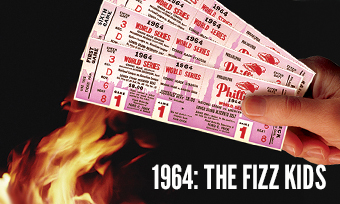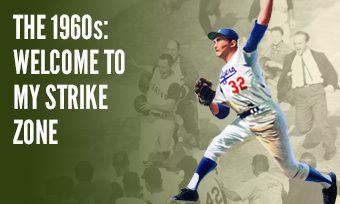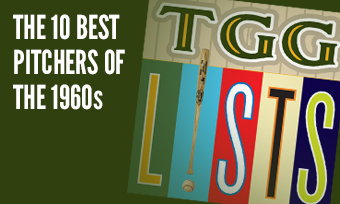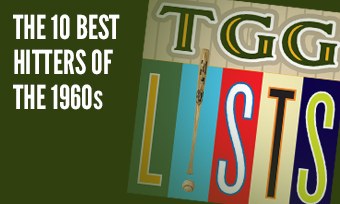The Yearly Reader
Leaders and Honors, 1964
Our list of baseball’s top 10 hitters and pitchers in both the American League and National League for the 1964 baseball season, as well as the awards and honors given to the game’s top achievers of the year.
The National League’s Top 10 Hitters, 1964
Bold type in brick red indicates league leader.
1. Willie Mays, San Francisco
Key Numbers: .296 average, 121 runs, 171 hits, 21 doubles, 9 triples, 47 home runs, 111 RBIs, 82 walks, 19 stolen bases, .607 slugging percentage.
Mays was named the first-ever black captain of a major league ballclub and responded with one of his best years yet; he was the only player to score five runs in a game during 1964—and he did it twice.
2. Richie Allen, Philadelphia
Key Numbers: .318 average, 125 runs, 201 hits, 38 doubles, 13 triples, 29 home runs, 91 RBIs, 138 strikeouts.
Allen led all players in home runs during spring training, then let pitchers know in his rookie regular season that it was no fluke.
3. Ron Santo, Chicago
Key Numbers: .313 average, 94 runs, 185 hits, 33 doubles, 13 triples, 30 home runs, 114 RBIs, 86 walks, .398 on-base percentage.
In his fifth season with the Cubs, the 24-year-old Santo emerged as a true Wrigleyville favorite with an all-around year at the plate; he also won his first of five straight Gold Gloves at third base.
4. Frank Robinson, Cincinnati
Key Numbers: .306 average, 103 runs, 174 hits, 38 doubles, 6 triples, 29 home runs, 96 RBIs, 79 walks, 20 intentional walks, 23 stolen bases.
After a relatively poor season by his standards, Robinson refreshed—and continued to command respect by leading the NL in intentional passes for the fourth straight year.
5. Hank Aaron, Milwaukee
Key Numbers: .328 average, 103 runs, 187 hits, 30 doubles, 24 home runs, 95 RBIs, 22 stolen bases.
A very un-Aaron-like year, as Hammerin’ Hank hit the fewest home runs between his rookie 1954 season and his final year at Atlanta (1974). But when you hit .328 and steal 22 bases, no one’s going to complain.
6. Billy Williams, Chicago
Key Numbers: .312 average, 100 runs, 201 hits, 39 doubles, 33 home runs, 98 RBIs, 10 stolen bases.
Forming a terrific one-two punch in Chicago with Ron Santo, the quiet and tireless Williams was hitting .400 as late as June 9 before cooling off into the summer months.
7. Rico Carty, Milwaukee
Key Numbers: 133 games, .330 average, 28 doubles, 22 home runs, 88 RBIs.
In a great year for rookies, Carty—who played long enough to be managed by Tony La Russa—twice collected five hits in a game, six days apart.
8. Ken Boyer, St. Louis
Key Numbers: .295 average, 100 runs, 185 hits, 30 doubles, 10 triples, 24 home runs, 119 RBIs, 70 walks.
It could be argued that Boyer had better years statistically, but he was never more valuable than in 1964.
9. Roberto Clemente, Pittsburgh
Key Numbers: .339 average, 95 runs, 211 hits, 40 doubles, 7 triples, 12 home runs, 87 RBIs.
Clemente collected a career-high 211 hits and 40 doubles on his way to his second of four batting titles.
10. Orlando Cepeda, San Francisco
Key Numbers: .304 average, 27 doubles, 31 home runs, 97 RBIs.
Though he didn’t know it at the time, this would be Cepeda’s last productive year for the Giants; a problematic knee got the better of him a year later and, once healed, he couldn’t unseat Willie McCovey at first base—leading to a 1966 trade to St. Louis.
The American League’s Top 10 Hitters, 1964
1. Mickey Mantle, New York
Key Numbers: .303 average, 92 runs, 25 doubles, 35 home runs, 111 RBIs, 99 walks, 18 intentional walks, .423 on-base percentage.
The last great year for the Mick in the Yankees’ final hurrah before the CBS-era gloom kicked in.
2. Tony Oliva, Minnesota
Key Numbers: .323 average, 672 at-bats, 109 runs, 217 hits, 43 doubles, 9 triples, 32 home runs, 94 RBIs, 12 stolen bases.
Fast start, gradual fade: Oliva mimicked Vada Pinson with a superb rookie effort followed by a glacial career decline that ultimately made him one of the best players not in the Hall of Fame.
3. Bob Allison, Minnesota
Key Numbers: .287 average, 90 runs, 27 doubles, 32 home runs, 86 RBIs, 92 walks, 10 stolen bases.
The veteran “play me wherever” Allison split his time between first base and the outfield, but his favorite place to perform certainly had to be at Metropolitan Stadium, where he batted .342 (as opposed to .241 on the road).
4. Harmon Killebrew, Minnesota
Key Numbers: .270 average, 95 runs, 49 home runs, 111 RBIs, 93 walks, 8 hit-by-pitches.
Roger Maris had to wonder how safe his season home run record was after Killebrew hit 28 home runs over the Twins’ first 74 games of the year.
5. Brooks Robinson, Baltimore
Key Numbers: 163 games, .317 average, 82 runs, 194 hits, 35 doubles, 28 home runs, 118 RBIs, 10 sacrifice flies.
Yankees manager Yogi Berra’s chalkboard fodder wrote of Robinson’s bat fading in the summer, only encouraging the Orioles third baseman to step it up and complete his best offensive stint ever.
6. Boog Powell, Baltimore
Key Numbers: 134 games, .290 average, 39 home runs, 99 RBIs, 76 walks, .606 slugging percentage.
The 23-year-old boomer set a career mark for home runs—and it would have been more had he not missed 29 games, mostly due to a sprained wrist suffered in August.
7. Rocky Colavito, Kansas City
Key Numbers: .274 average, 89 runs, 31 doubles, 34 home runs, 102 RBIs, 83 walks.
Having left behind fans in Cleveland and Detroit angered over his being traded, the popular Colavito was in the process of winning over a new group of fans in Kansas City in what would turn out to be his only year with the A’s.
8. Dick Stuart, Boston
Key Numbers: .279 average, 27 doubles 33 home runs, 114 RBIs.
Stuart’s short tenure in Boston came to an end after two years—and while it looked great on paper, continued bad defense and a shaky relationship with manager Johnny Pesky sealed his fate with a trade to the Phillies.
9. Jim Fregosi, Los Angeles
Key Numbers: .277 average, 86 runs, 22 doubles, 9 triples, 18 home runs, 72 RBIs, 72 walks.
In the first 18 years of Angels baseball, there were two instances of a player hitting for the cycle; they both came courtesy of Fregosi, who accomplished his first in 1964.
10. Leon Wagner, Cleveland
Key Numbers: 163 games, .253 average, 94 runs, 31 home runs, 100 RBIs, 14 stolen bases.
After three years and 91 home runs for the Angels—where he gave himself the nickname “Daddy Wags” because of his friendly disposition toward the press—Wagner took his cheerful act to Cleveland where he continued to pound away.
The National League’s Top 10 Pitchers, 1964
1. Don Drysdale, Los Angeles
Key Numbers: 2.18 ERA, 18 wins, 16 losses, 40 starts, 21 complete games, 321.1 innings, 11 wild pitches.
A dried-up Dodgers offense could only explain Drysdale’s terrific ERA—and ordinary won-lost record.
2. Sandy Koufax, Los Angeles
Key Numbers: 1.74 ERA, 19 wins, 5 losses, .792 win percentage, 28 starts, 7 shutouts, 223 innings.
Koufax was on pace to win 25 games and strike out nearly 300 batters when he made what turned out to be his last start of the year in mid-August, bowing to ever-increasing arthritic issues in his pitching arm.
3. Juan Marichal, San Francisco
Key Numbers: 2.48 ERA, 21 wins, 8 losses, .724 win percentage, 33 starts, 22 complete games, 269 innings, 52 walks.
Some pitchers just tire themselves out by September. Not Marichal; the major league leader in complete games started eight games from September 2 on—six of them on three days’ rest—and finished all but one of them. He pitched eight innings in the game he didn’t complete.
4. Chris Short, Philadelphia
Key Numbers: 2.20 ERA, 17 wins, 9 losses, 42 appearances, 31 starts, 220.2 innings, 51 walks.
Phillies manager Gene Mauch told Short to get aggressive with hitters; the results were telling.
5. Bob Veale, Pittsburgh
Key Numbers: 2.74 ERA, 18 wins, 12 losses, 38 starts, 279.2 innings, 124 walks, 250 strikeouts, 18 wild pitches, 33 grounded into double plays.
To steal from Basil Fawlty, Veale rose from the bullpen and became “Veale-ly good” within an otherwise patched-up Pirates rotation.
6. Larry Jackson, Chicago
Key Numbers: 3.14 ERA, 24 wins, 11 losses, .686 win percentage, 38 starts, 297.2 innings, 58 walks.
Jackson’s 24 wins were the most ever for an eighth-place team.
7. Jim Bunning, Philadelphia
Key Numbers: 2.63 ERA, 19 wins, 8 losses, .704 win percentage, 39 starts, 284.1 innings, 46 walks, 14 hit-by-pitches.
The Phillies’ ace exceeded Juan Marichal (#3 above) in September/October starts with a remarkable 10—but couldn’t make it past the fifth in three of them. It was the first of three straight years in which he won exactly 19 games.
8. Jim O’Toole, Cincinnati
Key Numbers: 2.66 ERA, 17 wins, 7 losses, .708 win percentage, 30 starts, 220 innings, 51 walks.
O’Toole’s five-year reign as a top Reds pitcher came to an end with arguably his most efficient set of numbers.
9. Bob Bruce, Houston
Key Numbers: 2.76 ERA, 15 wins, 9 losses, 35 appearances, 29 starts, 202.1 innings, 33 walks.
The common pitcher was going to miss Colt Stadium, where he posted a 20-10 record and 2.59 ERA over three years for Houston; he’d go 6-15 over the next three seasons at the Colt .45s/Astros’ new home, the Astrodome.
10. Bob Gibson, St. Louis
Key Numbers: 3.01 ERA, 19 wins, 12 losses, 40 appearances, 36 starts, 287.1 innings, 245 strikeouts.
Proving that he was warming up for a superb World Series effort, 11 of Gibson’s 19 wins came over the final two months of the season.
The American League’s Top 10 Pitchers, 1964
1. Dean Chance, Los Angeles
Key Numbers: 1.65 ERA, 20 wins, 9 losses, .690 win percentage, 4 saves, 46 appearances, 35 starts, 15 complete games, 11 shutouts, 278.1 innings, 31 grounded into double plays.
Channeling his outspoken anger over not receiving a raise from the Angels, Chance became a man on a mission on the mound; of the 11 shutouts he threw—the most by an American Leaguer since Walter Johnson—his most impressive was a 14-inning, three-hit gem against the Yankees on June 6.
2. Whitey Ford, New York
Key Numbers: 2.13 ERA, 17 wins, 6 losses, .739 win percentage, 36 starts, 8 shutouts, 244.2 innings, 57 walks, 0 stolen bases allowed.
Like Mickey Mantle, Ford would bask in the glory of one last great Yankee campaign before it all went south the next season; for the fourth and final time, he didn’t allow a single stolen base.
3. Dick Radatz, Boston
Key Numbers: 2.29 ERA, 16 wins, 9 losses, 29 saves, 79 appearances, 0 starts, 157 innings.
At Boston, there was the Green Monster, and then there was simply “The Monster,” Radatz—one of the majors’ best closers at 6’5”, 250 pounds.
4. Gary Peters, Chicago
Key Numbers: 2.50 ERA, 20 wins, 8 losses, .714 win percentage, 36 starts, 273.2 innings, 105 walks, 15 wild pitches, 27 grounded into double plays.
After missing out on 20 wins in his 1963 rookie campaign by losing his last two starts, Peters secured the magic number by winning his last four decisions. Unfortunately, none of his wins came against the Yankees (losing three), a bit of a downer given the White Sox finished just a game behind New York.
5. Juan Pizarro, Chicago
Key Numbers: 2.56 ERA, 19 wins, 9 losses, .679 win percentage, 33 starts, 239 innings, 55 walks.
The 27-year-old Puerto Rico-born southpaw hit peak with a career-high win total; he’d never win more than eight again despite pitching 10 more years, mostly out of the bullpen.
6. Joe Horlen, Chicago
Key Numbers: 1.88 ERA, 13 wins, 9 losses, 32 appearances, 28 starts, 210.2 innings, 25 grounded into double plays.
On a White Sox staff that produced the AL’s best team ERA (2.72) since 1918, Horlen became the first non-ERA champ with a sub-2.00 number since 1919.
7. Wally Bunker, Baltimore
Key Numbers: 2.69 ERA, 19 wins, 5 losses, .792 win percentage, 29 starts, 214 innings.
If not for Tony Oliva’s entry splash into the majors, Bunker would have been the AL Rookie of the Year; among his 15 wins were two one-hitters.
8. Fred Newman, Los Angeles
Key Numbers: 2.75 ERA, 13 wins, 10 losses, 32 appearances, 28 starts, 190 innings, 39 walks.
In his first of only two-full time campaigns as a starter, Newman understood the merits and demerits of pitching at low-scoring Dodger Stadium, posting a 10-4 record and 2.15 ERA at the Angels’ temporary home for one last season before moving to Anaheim.
9. Bob Lee, Los Angeles
Key Numbers: 1.51 ERA, 6 wins, 5 losses, 19 saves, 64 appearances, 5 starts, 137 innings.
As with Newman, the rookie closer was happy at Chavez Ravine—producing a 1.30 ERA. Overall, opposing batters hit just .182 against the right-hander.
10. Hoyt Wilhelm, Chicago
Key Numbers: 1.99 ERA, 12 wins, 9 losses, 27 saves, 73 appearances, 0 starts, 131.1 innings.
A remarkable stretch began for the 40-year-old Wilhelm with a streak of five straight years authoring a sub-2.00 ERA.









